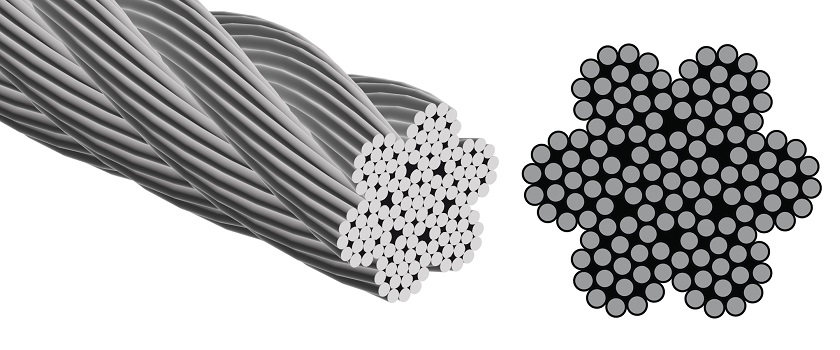When you’re picking out a steel wire rope, you need to know the key things that make sure you’re getting the right rope for your job. Steel wire ropes are used in a lot of different industries, like construction, shipping, and mining, because they’re strong and they can do a lot of different things. In this article, I’m going to explain the main things you need to know about steel wire ropes, like how they’re made, what they’re made out of, how strong they are, and what they’re coated with, so you can make a good choice.
People use steel wire ropes to lift, hoist, and secure heavy things. The things that make them work and last a long time, like how big around they are, what they’re made out of, and how they’re put together, make them do a good job and last a long time. For example, a lot of people use a 1/2-inch steel wire rope because it’s a good size for picking up just about anything. Also, steel wire ropes can have a coating on them, like galvanized, to keep them from rusting or be shiny (not coated) to make them stronger, so they can work in different places and do different things.
Now, let’s talk about these things and how they make steel wire ropes work.
Types of Steel Wire Ropes
When it comes to steel wire ropes, you need to know the different types and constructions so you can pick the right one. The most common types are stranded wire ropes and compacted ropes. Stranded wire ropes are made up of a bunch of strands of wires twisted together, like 6×19 or 6×36, and you use them for different things based on how flexible and strong they are. Compacted ropes are made to be tougher and resist wear and tear, so you use them for heavy-duty stuff.
Also, some steel wire ropes are made for specific things, like non-rotating ropes used in crane operations so the load doesn’t twist when you pick it up.
Key Specifications of Steel Wire Ropes
There are a few key things that determine what a steel wire rope can do:
- Diameter: The diameter of the wire rope is important because it tells you how much weight it can carry. For example, a 12mm rope is good for general lifting. The bigger the diameter, the more weight it can carry.
- Material: Steel wire ropes are usually made from high-carbon steel for general use or stainless steel if you need it to resist rust. High-carbon steel is really strong, while stainless steel is good for outdoor or marine use.
- Tensile Strength: This is how much tension the rope can take before it breaks. Steel wire ropes with high tensile strength are used for heavy-duty lifting and securing. For example, a 12mm rope can take over 10,000 kg before it breaks, so you can use it for really tough jobs.
- Lay: The lay of the wire rope is how the strands are twisted. You can get right lay (the strands are twisted in a right-hand direction) or Lang’s lay, which is more flexible and resists abrasion, so it’s good for lifting in rough places.
- Coating and Protection: Depending on what you’re doing, steel wire ropes can come with different coatings. You can get galvanized to stop it rusting or bright (uncoated) to make it stronger but less rust-resistant. Some ropes also have a plastic coating to give them extra protection in tough conditions.

Industry Standards for Steel Wire Ropes
Steel wire ropes have to meet a bunch of different industry standards to be safe and good. For example, ISO 2408 tells you what you need to know about steel wire ropes for general use. EN 12385 is the safety standard for ropes used to lift stuff. In the U.S., ASTM A1023/A1023M is the standard that tells you exactly what wire ropes have to be like to be safe and good enough to use.
These standards make sure that steel wire ropes are made and tested to do what you need them to do, whether you’re using them in construction or on a boat.
Applications of Steel Wire Ropes
Steel cables are used in a bunch of different industries:
- Construction and Lifting: Steel cables are used in cranes, hoists, and winches to lift and move heavy stuff. They’re strong and flexible, which makes them great for big construction jobs.
- Marine and Offshore: In the marine industry, cables are used to moor ships, tow boats, and support offshore platforms. People usually use galvanized or stainless steel cables for these things because they don’t rust.
- Mining and Logging: Mines and forests are tough on cables. They have to be able to handle a lot of tension and rubbing. People often use non-rotating cables in these places so they don’t have problems when they’re lifting and lowering stuff.
Maintenance and Durability
To make your steel wire ropes last longer and operate safely, you need to take care of them:
- Corrosion Resistance: If you use your ropes outside or on the water, you need to protect them from rust. Galvanized ropes or stainless steel options resist corrosion, so they last longer.
- Fatigue Resistance: If you bend your steel wire ropes back and forth a lot, you need ropes that resist fatigue. Compact ropes have a smoother surface, so they resist fatigue better and last longer.
You also need to inspect your ropes regularly to look for signs of wear, like broken wires or a smaller diameter. If you see any of these signs, you need to replace your rope. If you don’t, it could fail while you’re using it.
Conclusion
Steel cables are important in a lot of industries, and you need to know what you’re looking at when you’re buying one. The diameter, what it’s made of, how strong it is, and what it’s coated with all affect how well it works and how long it lasts. If you know what you’re looking for and you take care of it, you can use it safely and effectively for all kinds of things, from building stuff to working offshore.



